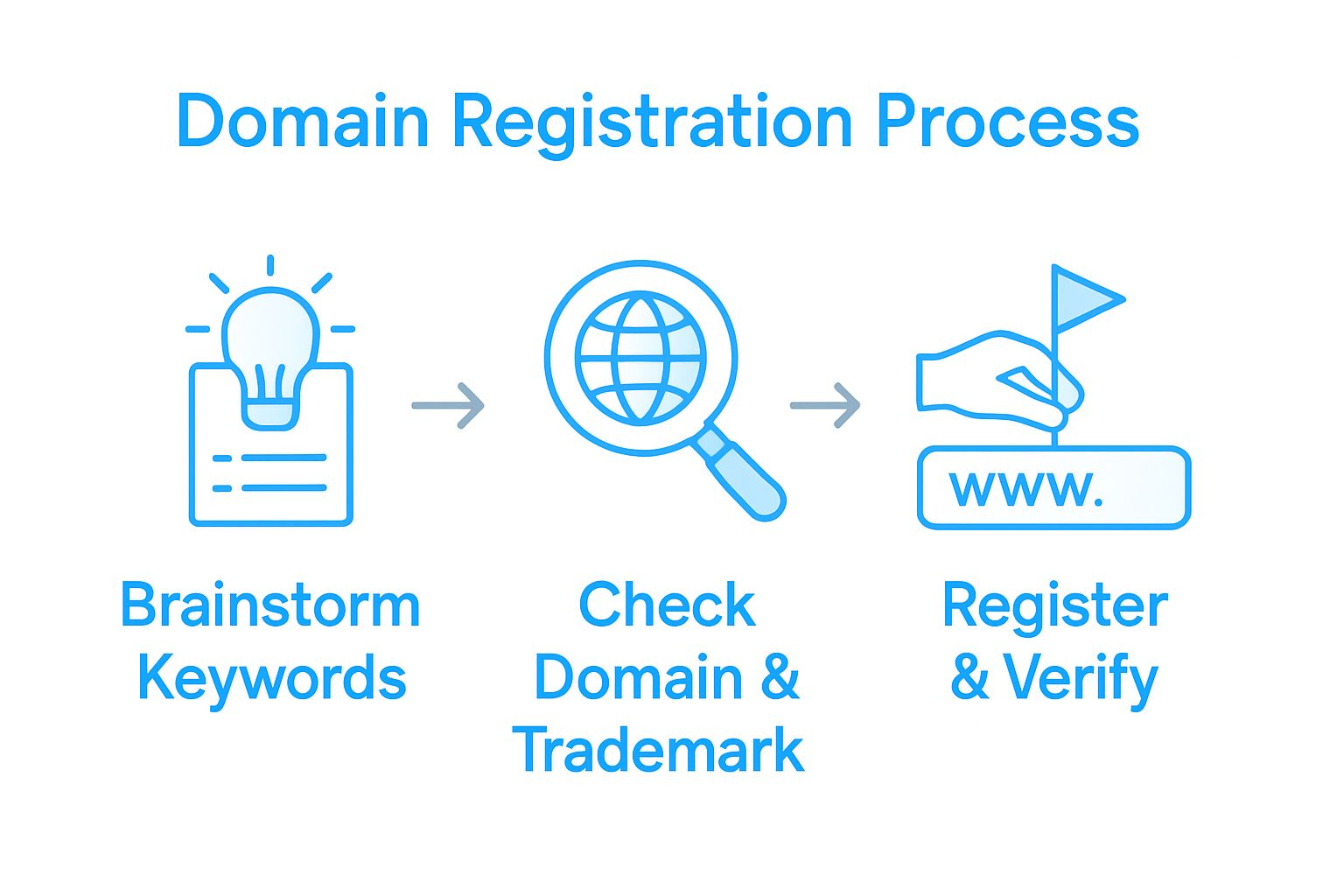Choosing a domain name might seem like a straightforward tick-box for launching your website. But nearly 56% of consumers say they judge a business’s credibility based on its domain name alone. Here’s what catches people off guard. A misstep with your domain can affect trust, SEO, and whether customers ever click on your site at all. Most folks focus on what’s available, yet the real game is all about crafting a digital identity that truly speaks to your audience.
Table of Contents
- Step 1: Define Your Brand Identity And Target Audience
- Step 2: Brainstorm Relevant Keywords And Phrases
- Step 3: Evaluate Domain Extensions And Their Implications
- Step 4: Check Domain Availability And Potential Trademarks
- Step 5: Select And Register Your Chosen Domain Name
- Step 6: Verify All Details And Finalize Your Setup
Quick Summary
| Key Point | Explanation |
|---|---|
| 1. Define brand identity clearly | Understand your brand’s core values and unique offerings to align with your domain name effectively. |
| 2. Develop detailed customer personas | Create profiles shadowing target audience traits, online behaviours, and language to tailor your domain effectively. |
| 3. Generate relevant keywords strategically | Compile a comprehensive list of keywords that resonate with your business and customer searches for memorable domain naming. |
| 4. Evaluate domain extensions thoughtfully | Select domain extensions that align with your brand identity and audience perception for professional digital presence. |
| 5. Check availability and trademarks thoroughly | Conduct extensive checks not just for domain availability but also to avoid potential trademark disputes that can harm your brand. |
Step 1: Define your brand identity and target audience
Choosing a domain name isn’t just about finding an available web address. It’s about creating a digital identity that resonates with your business’s core essence and speaks directly to your target audience. Before you start brainstorming potential domain names, you need a crystal clear understanding of who you are as a brand and who you want to attract.
Start by conducting a comprehensive brand identity exploration. This means digging deep into your business’s fundamental characteristics. What are your core values? What makes your business unique in the marketplace? What problem do you solve for your customers? These questions form the foundation of your brand’s narrative and will significantly influence your domain name selection.
Your target audience research is equally critical. You’ll want to create detailed customer personas that go beyond basic demographics. Consider their online behaviours, digital preferences, and the language they use when searching for services like yours. For instance, a tech startup targeting young entrepreneurs will approach domain naming very differently from a traditional consulting firm targeting corporate executives.
Consider tools like Google Analytics, social media insights, and customer surveys to gather meaningful data about your potential audience. Pay attention to the keywords and phrases they use, their pain points, and their aspirations. This information will guide you towards a domain name that feels intuitive and memorable to your specific market segment.
When aligning your brand identity with your domain name, aim for something that feels authentic and memorable. Your domain should be a digital reflection of your brand’s personality whether that’s professional and serious, playful and innovative, or warm and approachable.
Key verification points that indicate you’ve successfully completed this step include:
- You can describe your brand’s core mission in a single, compelling sentence
- You have detailed customer personas with clear demographic and psychographic information
- You understand the specific language and search habits of your target audience
For more comprehensive insights into building a strong brand foundation, read our guide on understanding brand identity.
Step 2: Brainstorm relevant keywords and phrases
With your brand identity and target audience firmly established, you’re now ready to dive into the strategic process of generating keywords and phrases that will form the foundation of your domain name. This step transforms your brand understanding into potential digital identifiers that resonate with your audience and capture your business essence.
Begin by generating a comprehensive list of terms directly related to your business offering, industry, and unique value proposition. Think about the precise language your potential customers might use when searching for services or products like yours. For example, a digital marketing agency might generate keywords like “digital solutions”, “online marketing”, “brand growth”, or “web strategy”.
Utilize multiple research techniques to expand your keyword universe. Online tools like Google Keyword Planner, SEMrush, and Ubersuggest can provide insights into search volume, competition, and related terms. Pay special attention to long-tail keywords that are more specific and often less competitive. These nuanced phrases can help you craft a domain name that feels both distinctive and purposeful.
Consider the psychological and emotional triggers your keywords might evoke. A domain name isn’t just a technical address it’s a first impression. Words that suggest transformation, expertise, innovation, or reliability can create an immediate connection with your potential customers. For technology businesses, keywords suggesting speed or efficiency might resonate, while service-based businesses might emphasize trust and reliability.
As you brainstorm, keep certain practical constraints in mind. Your potential domain keywords should be relatively short, easy to spell, and avoid complex terminology that might confuse potential visitors. Steer clear of industry jargon that only specialists would understand.
Key verification points for successful keyword brainstorming include:
- You have generated at least 20-30 potential keyword combinations
- Your keywords reflect your brand’s core value proposition
- The terms feel natural and intuitive when spoken aloud
For deeper insights into crafting an effective digital strategy, explore our SEO campaign brief to understand how strategic keyword selection can amplify your online presence.
Step 3: Evaluate domain extensions and their implications
After generating a robust list of potential keywords, you’ll now enter a critical phase of domain selection: understanding and evaluating domain extensions. These seemingly small suffixes carry significant weight in how your digital presence is perceived and can dramatically impact your brand’s online credibility and user trust.
Traditionally, .com has been the gold standard of domain extensions, representing commercial entities and offering instant global recognition. However, the digital landscape has evolved, presenting entrepreneurs with a diverse range of options that can strategically communicate your brand’s unique positioning. Country-specific extensions like .co.za signal a local South African presence, while industry-specific extensions such as .tech or .digital can immediately communicate your business sector.
Consider your target audience and business objectives when selecting an extension. A nonprofit might choose .org to underscore its mission-driven nature, while a technology startup could leverage .io to suggest innovation and technical prowess. Some extensions are more memorable and can even become part of your brand narrative. The key is selecting an extension that feels intuitive and aligns with your brand’s storytelling.
Financial considerations are also crucial. While classic extensions like .com are often more expensive, newer alternatives can offer cost-effective solutions without compromising professionalism. Some emerging extensions are significantly more affordable and can provide creative branding opportunities. According to global domain name research, the proliferation of domain extensions has created unprecedented flexibility for businesses seeking distinctive online identities.
Be mindful of potential challenges. Some less common extensions might be perceived as less credible by more conservative audiences. Additionally, ensure your chosen extension doesn’t create confusion or unintentionally mislead potential visitors about your business type.
Verification points for successful domain extension evaluation include:
- You understand the implications of different domain extensions
- The chosen extension aligns with your brand’s professional image
- You’ve considered both branding impact and budget constraints
Remember that your domain extension is more than a technical requirement it’s a strategic branding decision that communicates volumes about your business in a single, compact identifier.
Step 4: Check domain availability and potential trademarks
With your carefully selected keywords and preferred domain extension in hand, you’re now entering a critical verification phase that could save you significant time, money, and potential legal complications. Checking domain availability and potential trademark conflicts is not just a technical step it’s a strategic safeguard for your brand’s digital future.
Begin by conducting a comprehensive domain availability search across multiple platforms. While domain registrars like GoDaddy, Namecheap, and local South African providers offer instant availability checks, don’t rely solely on these tools. Explore variations of your preferred domain name to ensure you have backup options if your first choice is unavailable. Consider slight modifications like adding hyphens, changing word order, or exploring alternative extensions that maintain your original brand essence.
Parallel to domain availability, you must conduct a thorough trademark investigation. This step goes beyond simple domain searching and requires careful legal consideration. Use resources like the Companies and Intellectual Property Commission (CIPC) in South Africa to verify that your proposed domain name doesn’t infringe on existing trademarks. According to global intellectual property guidelines, early trademark verification can prevent expensive rebranding or potential legal disputes down the line.
Remember that trademark conflicts aren’t just about exact matches. Even phonetically similar names or brands operating in closely related industries can create legal complications. Some businesses mistakenly believe that different industries provide blanket protection this is a dangerous assumption.

Consider engaging a legal professional specialising in intellectual property if your proposed domain name is critical to your business strategy. While this might seem like an additional expense, it’s significantly more cost-effective than potential future legal challenges.
Key verification points for successful domain and trademark checking include:
- You’ve confirmed domain availability across multiple platforms
- You’ve conducted a comprehensive trademark search
- You have at least 3-5 alternative domain name options
Learn more about securing your online presence with our domain registration guide, which provides additional insights into navigating this complex process.
Step 5: Select and register your chosen domain name
You’ve navigated the complex journey of domain selection, and now arrives the moment of digital transformation: registering your chosen domain name. This isn’t merely a transactional process it’s the official establishment of your online identity and the foundation of your digital presence.
Choose a reputable domain registrar that offers comprehensive services beyond simple registration. Local South African providers like Webnic.co.za or international platforms such as GoDaddy provide different advantages. Consider factors like pricing, customer support, additional security features, and ease of management. Some registrars offer bundled services like email hosting, SSL certificates, and website builders that can provide exceptional value for emerging businesses.
Before finalising your registration, conduct a final review of your selected domain. Verify the exact spelling, extension, and potential pronunciation challenges. A seemingly perfect domain can quickly become problematic if it’s difficult to communicate verbally or prone to common misspellings. Consider how it sounds when spoken aloud during phone calls or networking events.
Financial planning is crucial during registration. Most domains require annual renewal, so understand the initial and recurring costs. Many registrars offer multi-year registration options that can provide cost savings and ensure long-term domain stability. According to international domain registration standards, selecting an ICANN-accredited registrar ensures you’re working with a legitimate and regulated service provider.
Privacy protection is another critical consideration. Many registrars offer domain privacy services that shield your personal contact information from public WHOIS databases. This can protect you from potential spam, unsolicited marketing, and reduce the risk of personal information exposure.
Key verification points for successful domain registration include:
- You’ve selected a reputable, ICANN-accredited registrar
- Your domain is registered for at least one year
- You’ve enabled domain privacy protection
- You have documented login credentials and renewal information
- You’ve confirmed all personal and billing details are accurate
Remember, your domain name is more than a technical address it’s the digital front door to your business. Treat its selection and registration with the strategic importance it deserves.
Here is a checklist table to help you verify that all recommended actions and checks have been completed during the domain registration and setup process.
| Verification Step | Description | Completion Criteria |
|---|---|---|
| Brand identity defined | Clearly articulate brand values and mission | One-sentence mission statement |
| Customer personas developed | Detailed audience profiles with behaviours and preferences | Profiles with demographic data |
| 20-30 keywords brainstormed | Comprehensive list of relevant keywords and phrases | List of at least 20 keyword ideas |
| Domain extension evaluated | Consideration of branding, audience, and cost implications | Extension chosen matches objectives |
| Domain availability confirmed | Searched across multiple platforms for availability | Choice and 3-5 alternatives ready |
| Comprehensive trademark search conducted | Checked business, trade, and trademark databases | No conflicts identified |
| Registered with ICANN-accredited registrar | Selection of reputable, secure domain provider | Registration confirmation received |
| All contact and billing details verified | Double-checked details for accuracy | No spelling errors or omissions |
| DNS and security features configured | Set up DNS, privacy protection, and registrar lock where possible | Setup confirmation email received |
| Domain renewal mechanism established | Enabled auto-renewal and stored credentials securely | Renewal process is active |
Step 6: Verify all details and finalize your setup
Congratulations on successfully registering your domain name. Now begins the critical phase of verification and setup that transforms your digital claim from theoretical to operational. This isn’t just a technical checklist it’s the moment your online identity becomes functional and secure.
Start by thoroughly reviewing all registration details to ensure absolute accuracy. Verify your contact information, billing details, and domain registration credentials. Even a minor typo can create significant administrative complications down the line. Double-check your email address associated with the domain, as this will be your primary communication channel for renewal notices, security alerts, and critical domain management communications.
Next, configure your domain’s DNS (Domain Name System) settings. This technical step determines how your domain will connect to web hosting, email services, and other digital platforms. Most registrars provide user-friendly interfaces for this process, but if you’re uncertain, consider consulting with a technical professional who can ensure precise configuration. Proper DNS setup is crucial for ensuring your website and associated services function seamlessly.
Securing your domain goes beyond initial registration. Implement robust security measures like domain privacy protection, which shields your personal information from public databases, and enable registrar lock features that prevent unauthorized domain transfers. According to international domain registration standards, maintaining accurate and verifiable contact information is not just recommended it’s a regulatory requirement.
Prepare for ongoing management by creating a systematic approach to domain maintenance. Set up automatic renewal to prevent accidental domain expiration, which could result in losing your carefully selected web address. Create a secure password management system for your domain registrar account, potentially using enterprise-grade password managers that offer two-factor authentication.
Key verification points for successful domain setup include:
- All registration details are 100% accurate
- DNS settings are correctly configured
- Security protections are activated
- Renewal mechanisms are established
- Backup access credentials are securely stored
Remember, your domain is more than a technical asset it’s the digital foundation of your brand’s online ecosystem. Treat its setup with the strategic precision it deserves.

Ready to Turn Your Perfect Domain Name Into a Powerful Online Presence?
You have learned how critical it is to define your unique brand, select the right keywords, and secure a strategic domain. Yet the real challenge comes after registration: How do you leverage your new digital identity to attract customers, build credibility, and stand out in a crowded South African market? Many businesses stall after acquiring the ideal domain because building a responsive, professional website that matches their brand’s promise and meets audience expectations can feel overwhelming.
Take your momentum forward with a partner who understands the art and science behind effective digital transformation. With custom web design and development solutions tailored specifically for your business, Cloudfusion turns your domain into a fully-fledged brand experience. Our expertise goes beyond just design. We integrate your new domain, support industry-specific needs, and help propel your business online. Act now to claim your place in the digital landscape. Begin by requesting a tailored web design and development quotation or explore more about our full-service offerings at Cloudfusion. Secure a digital foundation that reflects your vision and moves your business forward today.
Frequently Asked Questions
How do I define my brand identity before choosing a domain name?
To define your brand identity, identify your core values, unique differentiators, and the problems you solve for your customers. Create a one-sentence mission statement that encapsulates your brand essence and serves as a guide during the domain selection process.
What are the key elements to consider when brainstorming keywords for my domain name?
Focus on keywords that reflect your business offerings and industry while resonating with your target audience’s language. Aim to generate a list of 20-30 potential keyword combinations to ensure variety and relevance.
How do I choose the right domain extension for my business?
Select a domain extension that aligns with your business type and audience perception, such as .com for commercial sites or .org for nonprofits. Assess the perceived credibility of different extensions and consider how they fit into your overall brand narrative.
What steps should I take to ensure my chosen domain name is available and trademark-free?
Conduct a thorough search across multiple registrars to check domain availability and perform a comprehensive trademark investigation. Make sure to have 3-5 alternative domain name options ready in case your preferred choice is unavailable.
What should I verify before registering my domain name?
Before finalizing your registration, double-check the spelling, extension, and potential mispronunciation issues of your chosen domain name. Ensure that all personal and billing details are accurate to prevent complications during renewal or management.
How can I secure my domain after registration?
Actively implement security measures such as domain privacy protection and registrar lock features to safeguard your personal information and prevent unauthorized transfers. Set up automatic renewal to avoid accidental expiration of your domain in the future.








